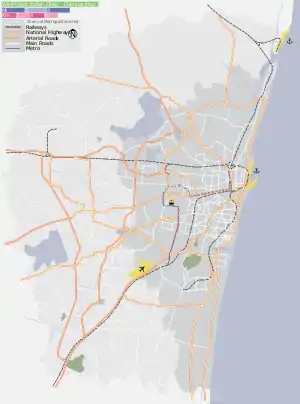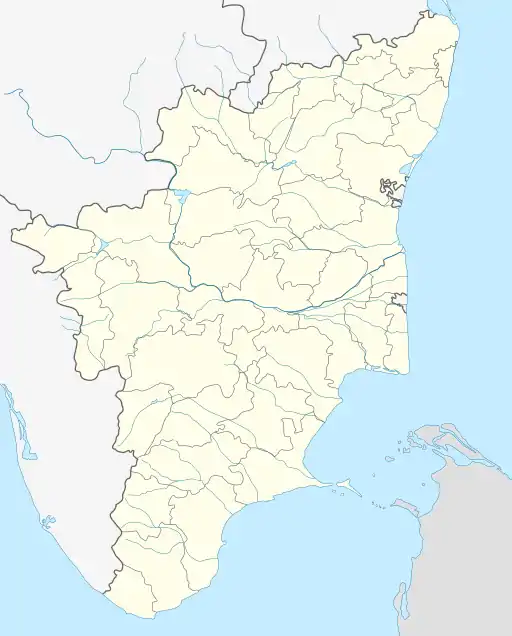Royapettah
Royapettah is a neighbourhood of Chennai, India. Located close to the central business district, the neighbourhood is one of the prime residential and commercial areas of Chennai.
Royapettah
இராயப்பேட்டை | |
|---|---|
 Royapettah  Royapettah  Royapettah | |
| Coordinates: 13°03′14.0″N 80°15′50.6″E | |
| Country | |
| State | |
| District | Chennai |
| Taluk | Egmore |
| Metro | Chennai |
| Zone & Ward | 9 & 118 |
| Elevation | 9 m (29 ft) |
| Population (2011) | |
| • Total | 14,912[1] |
| Languages | |
| • Official | Tamil |
| Time zone | UTC+5:30 (IST) |
| PIN | 600014 |
| Telephone code | 044 |
| Vehicle registration | TN-01 |
| Civic agency | Greater Chennai Corporation |
| Planning agency | CMDA |
| City | Chennai |
| LS | Chennai Central (Lok Sabha constituency) |
| VS | Thousand Lights |
| MP | Dayanidhi Maran |
| MLA | Vacant |
| MC | Vacant |
| Website | http://www.chennaicorporation.gov.in/ |
Location
Royapettah is located at the central part of the city of Chennai, with an elevation of 9 m (29 ft.) above mean sea level.[2] The neighbourhood comes under Teynampet Zone (number 9) and ward number 118 (old number 112) of the Chennai Corporation.[3]
Boundaries
Royapettah is bounded in the direction of Northwest by Nungambakkam, North by Chintadripet, Northeast by Chepauk, West by Gopalapuram, East by Triplicane, Southwest by Teynampet, South by Mylapore and Southeast by Marina Beach.
History
Royapettah, along with the suburbs of Nungambakkam and Teynampet, was part of the Great Choultry Plain, as the British had it in their records back in 1721.[4] Soon after the arrival of the British in the city in the early 17th century, a large Eurasian population started settling in Royapettah and surrounding regions in the 17th and 18th centuries.[5] Muslim settlements started appearing in the neighbourhood from the latter half of the 18th century.[6] In 1798, the British East India Company constructed the Amir Mahal to house its administrative offices.[7] When the Company annexed the Carnatic kingdom in 1855 with the Doctrine of Lapse, the Chepauk Palace, the official residence of the Nawabs, was auctioned off and purchased by the Madras government.[7] The Nawab moved to a building called Shadi Mahal on Triplicane High Road and lived there.[7] However, the British granted the Amir Mahal to the Prince of Arcot and the office building was soon converted into a palace by Robert Chrisholm.[8] In 1876, the Nawab moved in with his family into the Amir Mahal, which has since been the residence of the Nawabs of Arcot.[7]
The Purification Church was apparently the first church built in the neighbourhood around 1769. However, this was replaced in 1848 by the Presentation Church, also known as the Wallajahpet Church. Built on a 21-ground plot, this was granted by the Nawab in 1813.[9] The Subramania Swamy Temple located adjacent to the church was built around 1889 in the area now known as Zam Bazaar.[9] The Thousand Lights mosque was built in 1810. In 1819, the first Methodist chapel in India was opened in Royapettah by the Methodist missionary James Lynch who settled down in the neighbourhood a year before. The church grew into the Wesley Church, which was dedicated in 1853.[10]
In 1819, the Madras Eye Infirmary (MEI) as founded in the neighbourhood.[11][12] It remains the oldest specialist eye hospital in Asia and the second oldest in the world.[11] Modelled on Moorfield Eye Hospital in London, the hospital was moved to Egmore in 1884 and became the Government Ophthalmic Hospital in 1886.[11] The Government Royapettah Hospital was opened in 1911.[13] The first superintendent of the hospital was Col. C. Donovan.[14]
In 1858, Monahan Girls' School, one of the oldest Protestant schools, was opened in Royapettah.[10] In 1928, the neighbourhood had one of the earliest school for physical education in the Wesley School.[15] The Royapettah post office appeared in 1834 as a subsidiary of the General Post Office at George Town.[16] With the opening of the Woodlands Hotel in 1938 and the Modern Hindu Hotel on General Patter's Road, the neighbourhood became the home to the first Indian-style, vegetarian hotels in the city.[17]
In the 1930s, a clock tower was built in the neighbourhood. Gani and Sons, formerly known as the South India Watch Company, provided the clock instrument for the clock tower.[18]
Demographics
As of Census of India 2011, the total population of Royapettah was 14,912, including 7,444 males and 7,468 females.[19]
Transportation
Located centrally within the city, Royapettah is well connected to other neighbourhoods of Chennai, with several bus routes passing through it. Whites road, Avvai Shanmugam Salai and Royapettah High Road are the primary streets in the neighbourhood. The city's arterial Anna Salai tangentially touches the western periphery of the neighbourhood. Royapettah has a flyover on Royapettah High Road. There are plans to build a 5-kl/day sewage treatment plant along the pliers of the flyover and is under construction.[20]
Royapettah is served by the LIC and Thousand Lights metro stations on the Blue Line of the Chennai Metro, which runs along the western periphery of the neighbourhood.
Places of Worship
.jpg.webp)
Temples in Royapettah include the Subramania Swamy Temple, the Shri Srinivasa Perumal temple, and the Sidhi Budhi Vinayagar and Sundareswarar Temple. The penta-domed and bi-minaret Thousand Lights Mosque, designed by Nawab Umdat ul umrah, is the most famous mosque in the neighbourhood. It was built in 1810. The Wesley church located near the Clock Tower is one of the oldest churches in the neighbourhood. Wallajahpet Church is another old church in the neighbourhood.
Healthcare
The Government Royapettah Hospital, which serves as the chief healthcare institution in the neighbourhood, is the city's largest peripheral hospital[21] and its limit extends up to Chengalpattu.[22] Second in the government sector next only to the Rajiv Gandhi Government General Hospital, the Royapettah Government Hospital has a full-fledged emergency department, including triage area, resuscitation bay and colour-coded zones, per the Tamil Nadu Accident and Emergency Care Initiative (TAEI) guidelines.[23]
Economic notability
Located close to the central business district, Royapettah has several commercial establishments. The Express Avenue Mall is one of the major commercial buildings in the neighbourhood.
Education
The New College, one of the chief colleges in the city, is located in the neighbourhood.
Political notability
Royapettah comes under Thousand Lights state assembly constituency and Chennai Central (Lok Sabha constituency).[24] The suburb also hosts the headquarters of the Tamil Nadu Congress Committee and the All India Anna Dravida Munnetra Kazhagam.
Geolocation
See also
Citations
- "Census of India 2011: District Census Handbook, State Tamil Nadu, Chennai (Royapettah is ward no. 0112)" (PDF). Office of the Registrar General and Census Commissioner, India. Retrieved 19 October 2020.
- "Search Coordinates and Elevation of Royapettah Tamil Nadu India". Google Earth. Retrieved 9 October 2020.
- "Welcome to Greater Chennai Corporation/Zone details". Greater Chennai Corporation. Retrieved 6 November 2020.
- Muthiah 2014, p. 442.
- Muthiah 2014, pp. 77–78.
- Muthiah 2014, p. 5.
- Muthiah 2004, p. 168.
- Jayewardene-Pillai 2007, p. 200.
- Muthiah 2014, p. 197.
- Muthiah 2014, p. 389.
- Muthiah 2014, p. 372.
- Parthasarathy, The Hindu 16 October 2012.
- TNHealth.org, n.d.
- Muthiah 2014, p. 369.
- Muthiah 2014, p. 100.
- Muthiah 2014, pp. 330–331.
- Muthiah 2014, pp. 76–77.
- Venkatraman, The New Indian Express, 27 August 2012.
- "District Census Handbook, Chennai, Village and Town Directory" (PDF). Directorate of Census Operations, Tamil Nadu. Office of the Registrar General and Census Commissioner, India. p. 30. Retrieved 21 October 2020.
- "14 Chennai Flyovers to get vertical gardens". Times of India. 14 September 2020. Retrieved 6 November 2020.
- The Times of India, 17 August 2012.
- The Hindu, 30 April 2013.
- Josephine, The Hindu, 28 April 2019.
- "Thousand Lights Vidhan Sabha Election - Thousand Lights Assembly Election Results, Polling Stations, Voters, Candidates". Datanet India Pvt. Ltd. Retrieved 6 November 2020.
References
- Jayewardene-Pillai, Shanti (2007). Imperial conversations: Indo-Britons and the architecture of South India. Yoda Press. p. 200. ISBN 978-8190363426.
- Muthiah, S. (2004). Madras Rediscovered. East West Books (Madras) Pvt Ltd. ISBN 81-88661-24-4.
- Muthiah, S. (2014). Madras Rediscovered. Chennai: EastWest. ISBN 978-93-84030-28-5.
- Parthasarathy, Anusha (16 October 2012). "Looking back in time". The Hindu. Chennai: Kasturi & Sons. Retrieved 22 October 2020.
- Venkatraman, Janane (27 August 2012). "It's time to look at our city's landmarks again". The New Indian Express. Chennai: Express Publications. Retrieved 24 March 2014.
- "Government Royapettah Hospital". TNHealth.org. Archived from the original on 21 February 2013. Retrieved 28 April 2013.
- "Rs 10cr for cancer unit at Royapettah hospital". The Times of India. Chennai: The Times Group. 17 August 2012. Retrieved 28 April 2013.
- "Rs. 4 crore for survey of heritage hospital buildings". The Hindu. Chennai. 30 April 2013. Retrieved 12 May 2013.
- Josephine, M. Serena (28 April 2019). "Chennai's third full-fledged emergency dept. at KMC". The Hindu. Chennai: Kasturi & Sons. Retrieved 2 May 2019.
External links
 Media related to Royapettah at Wikimedia Commons
Media related to Royapettah at Wikimedia Commons